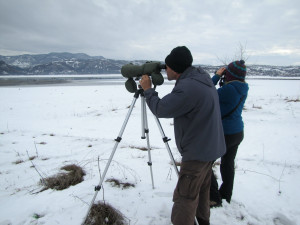On the weekend of 14-15 January, more than 7,000 birds of 32 different species were recorded at the annual mid-winter waterfowl census on the Arda River in the Eastern Rhodope Mountains. Experts and volunteers from Rewilding Rhodopes and the Bulgarian Society for the Protection of Birds observed some species that are rarely seen in the region.

One such guest was the tundra swan. As their common name implies, the tundra swan breeds in the Arctic and sub-arctic tundra. As winter approaches and the availability of food drops, the birds move south to their major wintering grounds on the coastal lowlands of northern Europe and East Asia. According to the experts, this rare encounter is largely due to the cold and snowy weather now gripping Nordic countries where the birds normally overwinter. Around 500 tundra swans were spotted earlier in January on the Black Sea coast.

Apart from these guests from the north, the team also encountered greater flamingo. Exotic visitors from the opposite direction, these birds generally prefer a warmer, Mediterranean climate. Their nearest frequent haunt to the Arda River is Lake Kerkini and Porto Lagos in Greece.
Mallard, common teal and a variety of grebes were the most abundant species in the census. Experts and volunteers also noted a significant presence of swans – both whooper and mute – with more than 200 birds. During the monitoring some endangered species, such as velvet scoter, common pochard and Dalmatian pelican, were also registered.
The census results once again confirm the importance of the region for the conservation of global biodiversity. Interestingly enough, greylag and greater white-fronted geese were sighted in the Studen Kladenets Dam area. Both of these species were last seen here in the late 1990s.

During the annual census all the major water bodies of the Eastern Rhodope mountains were monitored, including the lakes behind the Studen Kladenets, Kardzhali and Ivaylovgrad Dams. The greatest number of birds (more than 5000) was recorded near the Studen Kladenets Dam, while the lowest total (175) was recorded in the region of the Kardzhali Dam. The last few years have witnessed a decline in the number of birds recorded, but experts are still unsure as to the cause.
The Mid-Winter Waterfowl Census is an initiative of Wetlands International. Conducted across Europe, it began in 1967. In Bulgaria the initiative is overseen by the Bulgarian Society for the Protection of Birds. The purpose of the census is to estimate waterfowl populations across Europe, and to assess the condition of the wetlands where they overwinter.
